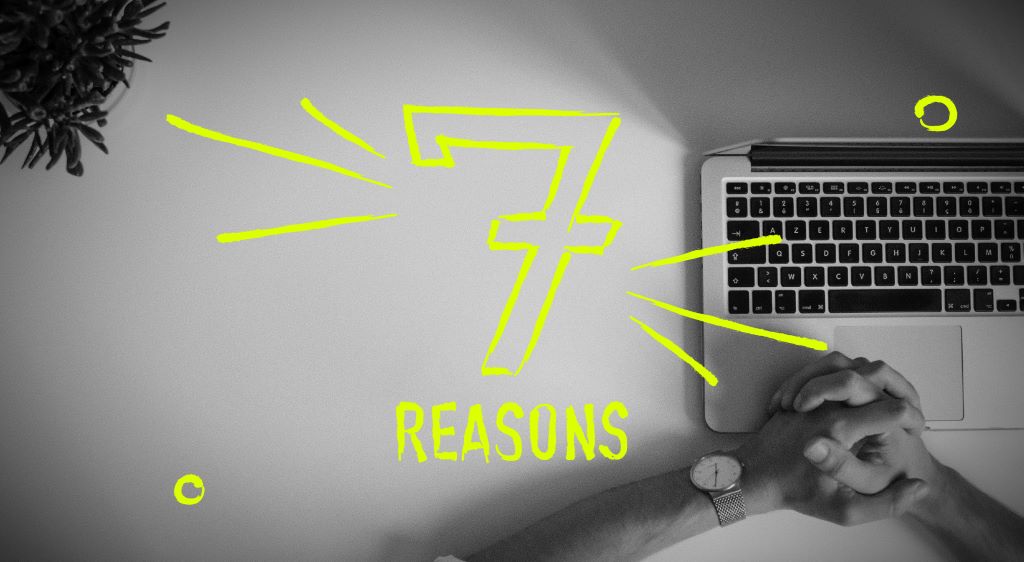The 5 Things That Slow Marketing Down & How to Deal With Them
There are things that let you grow fast, and then there are things that slow your growth down. Combine them together and you’ll feel like you’re doing so many things and all for nothing because marketing obstacles business owners face can get you stuck at the same place or make your growth so insignificant you won’t even notice it.
We know the pain because we do all the same mistakes. And it’s okay for every baby business. What’s not okay is if you don’t do your homework to analyze what things are actually bad for you. We did ours and decided to share with the rest of you because from what we’ve heard from our friends and partners was mainly “Oh my, we did the same and couldn’t figure out what went wrong”.
So here you go. I hope none of these typical marketing obstacles will sound relatable. But if they do, you know how to handle them.
1. Outsourcing small-budget marketing projects
Doesn’t matter what you’re outsourcing: SEO, Facebook Ads, or PR. The thing with outsourcing marketing small projects is that they are almost always not worth trying for from a perspective of a successful digital agency that actually delivers great results to their bigger clients. They will probably still take you onboard, but what you have to be prepared for is that they won’t dive into your business and study the market for you. And without doing those basic things that actually eat up a lot of time, the output they are gonna give you won’t be nearly as good as you’d want them to be with your small budget.
How to troubleshoot
Option A: hire a niche agency
An agency or a consultant may not be willing to go that extra mile for a small client researching the market, competitors, and the best strategies to go at it. They will simply do what they’ve already done for their other clients, and hope for the best.
But if you find someone who already knows the market, and, most importantly, your target audience, and understands your business model and challenges, they may be happy to have you as a client and become a valuable asset for your marketing team.
Option B: look for the rising star
Gurus and rockstar growth-hackers are great. But you know what’s even better? Hiring someone who wants to work with you really bad. The rising stars eager for their first clients appear every day. Of course, I wouldn’t recommend working with someone who has no experience at all but someone who’s switching from being a hired employee to freelance or starting their own company may be your hit. The reason is simple — one man’s trash is another man’s treasure, small budgets mean nothing to established agencies, but they mean the world when you’re someone’s first client.
Option C: hire a consultant and DIY
Spend the money on educating your in-house team. Hire a consultant to teach you how things are done, and help you throughout your journey. We did this by hiring one of the best experts in PPC and Facebook Ads we knew. He helped us get started, showed some cool tactics, and a direction to go to. Every week or two we’d meet again to show him the results and what we did exactly, he pointed out some mistakes we’ve made and gave ideas on how we could improve our performance. Within a month, we’ve spent on the same money we’d spend on hiring an agency but we already knew back then we were doing 5 times better job than any agency we’ve ever hired to do ads for us. Aftermath? Money very well spent.
How not to troubleshoot
Not an option: ask for discounts
What you definitely shouldn’t do is ask an agency you can’t afford to lower their prices for you. Not because it will make you look bad, no. Who cares? But because in the worst-case scenario they’ll say yes. And what you’ll get in the end is lousy work done by someone who wasn’t motivated enough to do it in the first place. Remember: cheapskate is a poor strategy for overcoming marketing obstacles.
2. Friends help for free
It’s so tempting to call a friend and ask for a favor, right? Wrong. Unless you need something that can be done within an hour or several specific questions you know they might answer. The thing is that a friend of yours may not be comfortable with asking you to pay them, and so they suggest doing your project for free. But we all know what happens when people try to work without getting any personal incentive: the work either never gets done or it’s not what you really expected. The bottom line is: you don’t want to work for free, so why someone else would?
We got into this trap once, and it wasn’t fun. We asked a friend who’s one of the best experts in their field to help find a contractor to finish a project, and he was so excited and kind to help us, he offered he’d take a look, free of charge. Of course, we should have known better how busy he was, and that the only thing we’d get out of this agreement would be pretty much an excuse to postpone the solution of something we didn’t know how to deal with. We should have known, because we’ve all done the same thing, and we all knew where it was going in the first place.
How to troubleshoot
Decline the kind offer
If they are a friend of yours, just be honest. If you don’t know how to be honest with your friend, just copy&paste the following passage:
“Thank you so much but I know how busy you are and how valuable your time is. It would be a waste if you’d spend it on doing the work we should have done ourselves for free.
If it’d be okay for you to accept money from us, let’s take that direction, and if it doesn’t feel right for some reason, I’d appreciate it if you could recommend someone who’d be good for the job.”
3. Perfectionism
How much time do you spend trying to do things right? I see so many marketers wasting weeks preparing to start doing something they’ve never done before, it drives me crazy! When you’re a new business, you can’t afford to feed your perfectionist ego with obsessing over tiny details. Just go and try it, if it works — it works, if it doesn’t — it doesn’t.
Here’s an example. If you’ve ever considered launching your product on ProductHunt and researched any guides with the best practices, you’d say a team should spend at least a month preparing for the launch. We’ve spent less than a week on that, and still got great results.
Analyzing whether we should have chosen another tactic we realized, that if we spent on that launch 4 times more resources, we’d only bring up the cost of this project. Would our ROI stay at least the same in that scenario? Honestly, we doubt that. We checked the hypothesis in a fast and efficient way, and we can see the results on our graphs:

Ever since then, we’ve tried many new things, some of them worked, others did not. What we’re most proud of is not wasting too much time on things that turned out to be not useful for our growth at all.
How to troubleshoot
The 24-hour rule
The best way to fight the perfectionist-procrastination infinite loop we’ve come up with is to test any new idea within 24 hours we decided it might be a good fit for our marketing mix. There is always some easy way to get started with a new traffic source or a growth hacking tactic. So don’t give yourself any time for self-doubt and second thoughts: just do it, and see what happens.
4. Focusing on strategic stuff too much
I am a content strategist. So, I can assure you that trying to create some kind of an ultimate marketing strategy for a startup from scratch and build a funnel that would lead several different types of your buyer personas from hearing about your product for the first time to purchase in 5 simple steps…yeah, probably not gonna happen.
What you end up with instead is probably this:
- Several weeks wasted on beautiful lead generation layouts that don’t work;
- Major burnout and confusion.
Not something a marketing person can afford in a startup or new business.
How to troubleshoot
Marketing Darwinism
The best strategy for businesses that haven’t found their strategy yet aka startups, is not to have a strategy. Instead, make a commitment to evolution through experiments.
Start off with the best guess you have, and do something. It doesn’t really matter what exactly. Measure the result, use it as a benchmark, come up with either a way to improve the result of your first experiment, or do something completely different and compare. The point is to improve your customer acquisition step by step and find the best tools and tactics that work for you along the way. You can and should build a strategy and think of long-term goals. What I’m saying is don’t expect to come up with the whole thing in one sitting. You have to get to know your market and customers first. Dissect this huge task into pieces and deal with it gradually.
The best practice we’ve picked up along the way is to write down all the hypotheses in a document: what’s the purpose of the experiment, how we want to approach it, how long it should last, and what expectations do we have. Consider noting your current obstacles to getting good marketing research too, as those are the factors influencing the results of the experiment.
E.g., you can keep track of your research methodology, or record your thoughts on the quality and relevance of the data gathered during the experiment.
Then, we add the end date of the experiment to Google calendar and go back to do the retrospective once it’s over. That way you won’t just rely on your gut feelings but will have data you won’t be able to argue.
5. Not focusing on strategic stuff enough
There are strategic things that are absolutely necessary to big companies but can hurt the smaller ones — no doubt on that. But that doesn’t mean you should disregard all of them. Those things usually have something to do with all the bureaucracy which holds the big corp together but pulls startups apart. It could be anything starting with an incredibly complicated workflow for fairly simple tasks to having to get approval from a manager before doing pretty much anything, or having a brand style guide just for the purpose of having it.
We’d never encourage adopting anything from big-name companies with a mindset that they would have known better. But you definitely should focus on any strategic task that would allow you to scale your business.
How to troubleshoot
Think repeatable
Things that allow our scale businesses are nearly always repeatable. Meaning, when you do something that brings you money or leads, or clients, or anything else your business model relies on, ask yourself: if we’d be doing this twice as much, would the profit double too? If the answer is yes, check your theory out. If it works again — that’s how you know you’ve found your opportunity to scale.
In our case, the scalable thing turned out to be content marketing. And what we’ve faced soon enough is that our in-house team can only do so much, and if we’d want to do more, we had to outsource some of our writing. What was the next big discovery? We couldn’t get quality content without sharing a writing style guide with the contractors and spent too much time editing the final drafts. The solution was to come up with a wireframe that required writers to send in a pitch so we could revise it before they make too many mistakes, and create a style guide we could share with them, so the tone of voice would make sense to our overall vision of the content we create.
The thing about such tasks is that they are incredibly time and energy-consuming. Not something you’d want to spend your time on if you don’t care about your copy that much. But for us, it has opened up a door to a whole new world and untied us. Find the thing that can help you grow on a long-term basis, and spend some quality time on that even if it seems that may not be that important at the moment.
Explore our stacks and pages: Google Play Services, Vue.js + PHP + Laravel, Cloudflare, IDEA, Intel XDK








